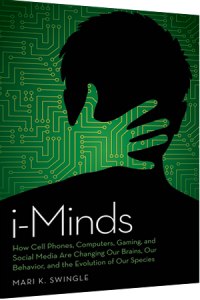
One of the research books I have been reading is Dr. Mari K. Swingle’s i-Minds: How Cell Phones, Computers, Gaming, and Social Media are Changing out Brains, Our Behaviour, and the Evolution of Our Species. The book was an interesting read to say the least. In this post, I will summarize the books key points and relate how it has influenced my inquiry.
Dr. Swingle is a clinical psychologist and graduate of UBC. Most of her book’s claims stem from either her own personal experience working with patients, or her research. She says from the outset that digital media is not inherently negative, but that there are alarming findings that suggest many youths addicted to digital media are being negatively impacted both emotionally and cognitively by the technology they are using. According to her, the key question we must ask ourselves is what it is i-media is facilitating – focus not on what digital media has given us, but rather what it has replaced or taken away (Swingle, 2015). Swingle’s analysis is based on three perspectives: the species-wide implications of overusing technology, the generation-specific changes and extent to which we immerse ourselves in digital media, and finally the extent to which people use digital media to either include or exclude activities or relationships.
The book argues that we are seeing an era of unprecedented arousal. We are being overstimulated and this has negatively affected our ability to self-regulate. This means that we are less able to self-stimulate and self-entertain, which has resulted in a reduced ability to observe, integrate information, and most importantly, be creative, “In essence, we have less ability to sustain focus on the normal, the baseline, including states of observation, contemplation, and transitions from which ideas spark – what many under the age of twenty now consider a void, proclaiming boredom” (Swingle, 2015).
The personal and cultural implications of this phenomenon has been an altered brain state, affecting learning socialization, and creativity. Swingle is in effect critiquing a society’s inability to reflect on its use of digital media – we have forgotten why we needed it to begin with. It is a daunting task, navigating this new, digital age, but this is true only insofar as we do not know where we are going. Swingle closes her book by reminding readers to “keep looking, keep examining, keep questioning, and be equally open to change and the potential of the future as to the wisdom of the past” (Swingle, 2015).
Dr. Swingle’s thoughts of hyper-arousal got me thinking: is there any educational benefit in having students bring their cellphones to class if they are not using them for learning? This prompted a further question: what are my students doing to “unplug” from their devices and reconnect with themselves and each other? What am I doing? I have decided that I am going to try to enforce a no cellphone policy in my classes (I say try because both of my SAs are relatively easy-going on this issue and the school adopts a “case-by-case” policy on cellphones). This might sound paradoxical for me to suggest that by banning technology from my classes, I can find innovative ways of bringing technology together with community. My response would be that if my value as an educator to society is based upon my ability to guide students in the social process of learning, then having technology in my classes is only beneficial insofar as it facilitates student learning, which means that not every minute of class time is tech time. If a no cellphone policy is to be successful, then I will have to devise a way of convincing my students to buy in to the idea. This “digital contract” is something I will need to research into and build upon in the new year.
In summary, Swingle’s book advocates for a more conscientious and therefore meaningful engagement with technology in our lives. My task then is to devise a means of restricting and promoting technology in the classroom, with the following guiding questions in mind for both myself and my students, “Where did we come from? Where are we now? Where are we going?”
Until next time,
Alex M.
